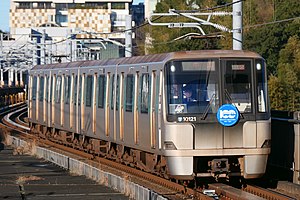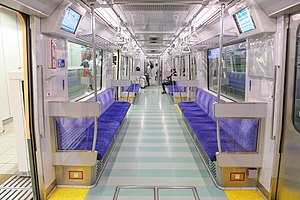Yokohama Municipal Subway 10000 series
| Yokohama Municipal Subway 10000 series | |
|---|---|
 Set 10121 in December 2021 | |
 Interior (December 2021) | |
| Manufacturer | Kawasaki Heavy Industries |
| Built at | Kōbe, Hyōgo |
| Constructed | 2007– |
| Entered service | March 2008 |
| Number under construction | 20 vehicles[1] |
| Number built | 68 vehicles (17 sets) |
| Number in service | 68 vehicles (17 sets) |
| Formation | 4 (future: 6) cars per trainset |
| Fleet numbers | 10011–10171 |
| Capacity | 380 (136 seated) per 4-car set |
| Operators | Yokohama Municipal Subway |
| Depots | Kawawa |
| Lines served | Green Line |
| Specifications | |
| Car body construction | Aluminium |
| Train length | 63.2 m (207 ft 4 in) |
| Car length | 16.1 m (52 ft 10 in) (end cars) 15.5 m (50 ft 10 in) (intermediate cars) |
| Width | 2.49 m (8 ft 2 in) |
| Height | 3,105 mm (10 ft 2.2 in) |
| Doors | 3 pairs per side |
| Wheel diameter | 660 mm (26 in) |
| Maximum speed | 80 km/h (49.7 mph) |
| Weight | 105 t (103 long tons; 116 short tons) |
| Traction system | Mitsubishi Electric MAP-144-15V154 IGBT–VVVF |
| Traction motors | Mitsubishi MB-7010-A 3-phase AC linear induction motor |
| Acceleration | 0.89 m/s2 (2.0 mph/s) |
| Deceleration | 0.97 m/s2 (2.2 mph/s) (service) 1.3 m/s2 (2.9 mph/s) (emergency) |
| Electric system(s) | 1,500 V DC (nominal) from overhead catenary |
| Current collector(s) | Pantograph |
| Safety system(s) | HD-ATC[2]/ATO |
| Track gauge | 1,435 mm (4 ft 8+1⁄2 in) standard gauge |
The Yokohama Municipal Subway 10000 series (横浜市交通局10000形) is a linear motor-powered electric multiple unit (EMU) operated by the Yokohama Municipal Subway on the Yokohama Municipal Subway Green Line since March 2008.
Formation
[edit]As of 1 April 2017[update], the fleet consists of 17 four-car sets with all cars motored, and formed as shown below with car 1 at the Nakayama end.[3] The sets are designed to allow the insertion of two centre cars at a later date, hence the numbering sequence that omits cars 3 and 4.
| Car No. | 1 | 2 | 5 | 6 |
|---|---|---|---|---|
| Designation | Mc1 | M2 | M5 | Mc6 |
| Numbering | 10xx1 | 10xx2 | 10xx5 | 10xx6 |
| Weight (t) | 26.5 | 26.0 | 26.5 | |
| Capacity (total/seated) | 88/31 | 102/37 | 88/31 | |
- "xx" indicates the individual set number.
- Cars 1 and 4 are each fitted with one single-arm pantograph.[3]
- Car 3 is designated as a mildly air-conditioned car.[3]
Interior
[edit]Passenger accommodation consists of longitudinal bench seating throughout.[4] Wheelchair spaces are provided in each car.[3]
-
Driver's cab
-
Interior view
-
Priority seating
-
LCD passenger information display
History
[edit]The first two pre-production sets, 10011 and 10021 were completed in May 2007 and shipped to Yokohama, arriving in June. The first full-production set, 10031, was delivered in July 2007, being hauled via JR tracks from the Kawasaki factory in Hyōgo Prefecture. The full-production sets feature a number of minor design improvements, including green-coloured gradations externally instead of the blue gradations used on the first two sets.
The trains entered service from 30 March 2008 with the opening of the Green Line.[3]
Two second-batch four-car sets were introduced from the start of the revised timetable on 29 March 2014.[5] These sets feature LED headlights, full-colour LED destination indicators, interior LED lighting, and 17-inch (430 mm) LCD passenger information displays.[5]
-
One of the pre-production sets, 10021, approaching Center-Minami in June 2019
-
3-color LED external information display
-
Full-color LED external information display
Future plans
[edit]In 2018, it was announced that ten of the 17 sets in operation would be lengthened to six cars each by 2024 as a measure to ease overcrowding on the Green Line.[1] The first lengthened trainset is expected to enter revenue service on 24 September 2022.[6]
Special liveries
[edit]From 25 February 2018, set 10161 began operating in a special cream and green vinyl wrapping livery based on the livery carried by former Yokohama city tramcars to mark the tenth anniversary of the opening of the Green Line.[7]
-
Set 10161 in April 2019
References
[edit]- ^ a b 横浜市グリーンラインに大型投資 混雑緩和へ6両化 [Large-scale investment on Yokohama Municipal Green Line - Lengthening to 6 cars to ease overcrowding]. Kanaloco (in Japanese). Japan: Kanagawa Shimbun. 30 January 2018. Archived from the original on 31 January 2018. Retrieved 31 January 2018.
- ^ Yokohama-shi Kо̄sokutetsudо̄ Kensetsu Shi 横浜市高速鉄道建設史 [Construction History of Yokohama City Rapid Transit] (in Japanese). Vol. III. Yokohama: Yokohama City Transportation Bureau. March 2011. p. 208. JPNO 21961538.
- ^ a b c d e 私鉄車両編成表 2017 私鉄車両編成表 2017 [Private Railway Rolling Stock Formations - 2017] (in Japanese). Japan: Kotsu Shimbunsha. 25 July 2017. p. 83. ISBN 978-4-330-81317-2.
- ^ 横浜市交通局10000形2次車量産車 [Yokohama Municipal Subway 10000 series full-production sets]. Japan Railfan Magazine (in Japanese). Vol. 48, no. 561. Japan: Koyusha Co., Ltd. January 2008. pp. 62–63.
- ^ a b 横浜市交通局10000形2次車 [Yokohama Municipal Subway 10000 series 2nd-batch sets]. Japan Railfan Magazine (in Japanese). Vol. 54, no. 638. Japan: Koyusha Co., Ltd. June 2014. pp. 78–79.
- ^ "横浜市営地下鉄グリーンライン、6両編成の運行は9/24から" [Yokohama Municipal Subway Green Line, 6-car train operation from 9/24]. Tetsudo Shimbun (in Japanese). 5 September 2022. Archived from the original on 5 September 2022. Retrieved 5 September 2022.
- ^ 横浜市交「グリーンライン10周年記念装飾列車」運転 [Yokohama Municipal Subway "Green Line 10th Anniversary Livery Train" enters service]. Japan Railfan Magazine Online (in Japanese). Japan: Koyusha Co., Ltd. 26 February 2018. Archived from the original on 27 February 2018. Retrieved 27 February 2018.









